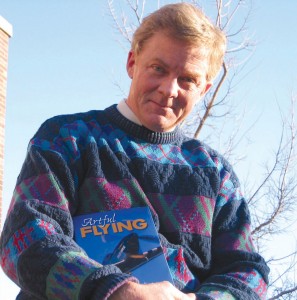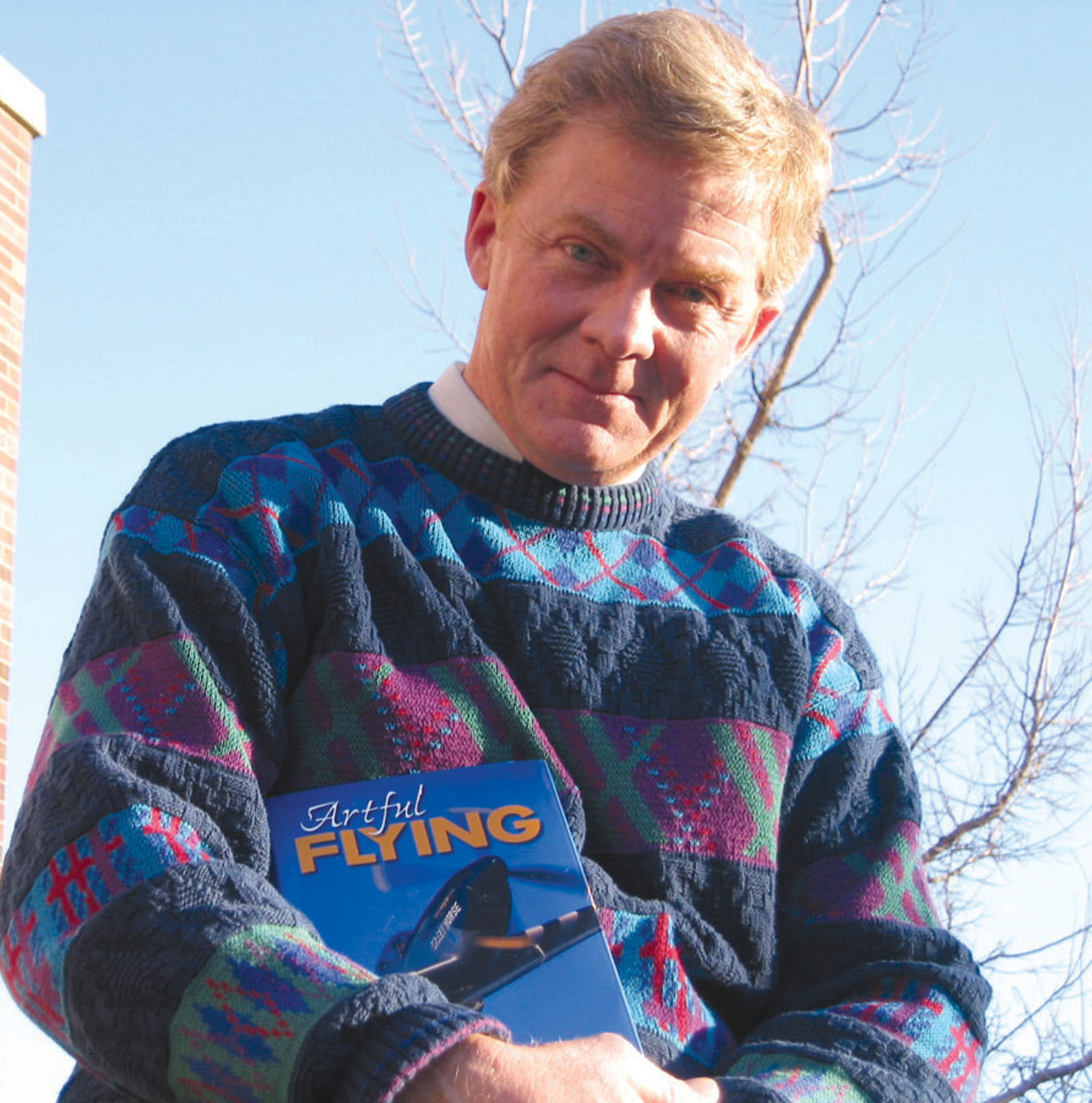By Trev Martin
It’s the constant need of improvement that an artisan loves so much. At least that’s what the author of the new book, “Artful Flying,” will tell you.

Michael Maya Charles, the author of “Artful Flying,” reveals there’s a creative process that should go into flying.
“There’s an artful process going on everywhere we look. In an airport terminal it’s no different, from the guy who’s shining shoes to the airline pilot,” says Michael Maya Charles. “People can see excellence in anything and truly enjoy working towards it.”
In “Artful Flying,” Charles utilizes an avant-garde narrative that pushes the threshold of the pilot’s psyche to unrealized potential. Though this is his first book, he details the depth and inner cortexes of the pilot’s mind, with classic narration and a style unique to aviation literature.
With his career resume of flight instruction, aircraft flown and maintained, flight hours and a stint at FLYING magazine, it’s easy to see this author knows the planes and helicopters about which he writes. But it took years to get there.
Charles, who now lives in Erie, Colo., spent his youth in southeastern Ohio, where he grew up on a horse farm. He was introduced to aviation at an early age.
“My fascination with flying machines goes back to grade school,” he said. “I was already smitten by the age of 11. My father used to take me to the airport when he began learning how to fly.”
At 15, Charles worked as a line boy for the local fixed base operation, pumping air and fuel, washing windows and running errands for pilots. He said he loved to listen to the seasoned pilots and elders, particularly two brothers, Don and Russ Hissam, who owned and operated the FBO.
“Don was the storyteller and Russ was the technical guy,” Charles said.
At such a young age, Charles was lucky to have such a learned team teaching him the discipline of flying. He wasn’t just dreaming about flying; he was living it and that definitely now permeates his work.
Moreover, he said, it was all about challenging himself early on and working his way towards excellence. Charles first soloed at 16, had his private license by his 17th birthday, and was a commercial pilot at 18. He worked as a charter pilot during college to help pay for his tuition, books and his first plane.
“It was a Pitts Special,” he smiles. “It kind of reflected where I was at that point in my life.”
In his mid 20s, he worked as a corporate pilot and a flight instructor at American Aeromotive. He said it was a tremendous place to learn about flying and also to learn how to become an excellent pilot.
Target audience
Charles said his book’s target audience is pilots and flight instructors.
“That’s whom I hope to impact the most,” he said.
His philosophy can be applied to any activity, but it especially pertains to pilots, because, as he says, it’s easy for flying to become monotonous. However, he said the “art of flying” alleviates that attitude. His book’s main premise is to make flying a fun and engaging process.
“We must engage in the process of flying, to improve, or we don’t stay involved,” he said.
Charles contends that a pilot can be artful in a plane that weighs half a ton or 300 tons.
“You work your way up to bigger and bigger planes, then you might get into helicopters or jets or some other type rating. That’s the beauty of it!” he said.
To illustrate this point, he detailed an experience he had on a Frontier Airlines flight. He closely monitored the pilot’s control of the Airbus and how he managed the flight plan from start to finish. When they landed, he went to the cockpit and told the pilot how enjoyable the flight had been and congratulated him on a flight well executed.
“Being the best at what you do requires practice, and not just the physical aspect of practice, but understanding exactly what it is you’re practicing,” he said. “Excellence is not to be confused with perfection, however. It’s a different mindset. The concept of obtaining perfection is crippling. The book is about a pursuit of the possible.”
Charles has been pursuing the possible since his first formal flight lesson at the age of 13. Even after three decades of being in aviation, first as a student and later, as an instructor, he quips that he’s never made a perfect flight.
“I’ve been very close, but never perfect,” he said.
He addresses the idea of the “perfect flight” in the book.
“Who hasn’t thought about that hypothetical ‘perfect flight’?” he asks. “I certainly have, but after almost 40 years of flying, I realize a perfect flight is impossible. It’s impossible because, in the real world, there are hundreds of variables you cannot control.”
Charles strongly advocates placing emphasis on some basic areas that can increase safety during flight. As he put it, this is a great way to revitalize every one of your flying moments. Flying doesn’t have to be hours and hours of boredom, punctuated by brief moments of sheer terror. It can be fun every single time you fly.
“We encounter lots of commonalities when flying,” he said. “‘Artful Flying’ is about helping someone find that place where he or she can do the very best flying they’re capable of–that includes flying as safely as possible.”
He stresses, however, that the book isn’t intended to make the reader “feel good–fast!” This isn’t a self-help book that uses flying as a means of conveyance, and it can’t be classified as a novel either. Rather, it’s a collection rich with anecdotes of colorful characters, complemented by a pilot’s perspective. It’s a nonfiction work, where years of experience permeate the pages and provide meaning that readers can assimilate into their own discipline of aviation.
When people ask Charles what exactly it means to be ‘artful’ at flying, his answer is that being artful is “to become a student of what you do.”
“You must understand where you want to excel, if you want to be excellent at what you do,” he said.
He uses the example of Leo Kottke, the guitar great, to convey his point. Kottke used to sit in a dark room, playing note after note on his box of wood and string until he understood every nuance. He defined each note and made music in a style all his own.
Nobody understands that point better than John Chmiel, a flight instructor for Wausau Flying Service in Wausau, Wis.
“I wanted to be a flight instructor all my life; I never aspired to be anything else,” Chmiel said. “A few years back, I made the decision to improve my flying.”
Chmiel met Charles at EAA AirVenture Oshkosh a few months ago and has since recommended “Artful Flying” to a large audience of pilots and flight students.
“It’s helped me as an instructor,” he said. “You’re flying and teaching at the same time. It’s helped me get some insight into what my students are thinking while they’re flying.”
As an instructor, this aspect draws Chmiel to the book, but he also notes how “Artful Flying” applies to all different aspects of life.
“Flying artfully can be taken beyond just the aspect of flying and into something completely different,” Chmiel said. “Insert the word ‘golfing’ or ‘writing’ or ‘investing.’ One can be artful at many things.”
Chmiel would agree that no matter where a person would like to excel, it’s the pursuit of excellence that Charles calls the process of artful flying.
The book is a culmination of about 14 years of work, writing notes on the backs of business cards, countless scraps of sectional charts and discarded approach plates. It’s also an outgrowth of the author’s work as an aviation photographer, experience as a marathon runner and study of eastern philosophy.
The not-yet-fully-recognized version of “Artful Flying” came to Charles a little over a decade ago, while he was writing an article for FLYING. It was a 1,200-word piece entitled “Cockpit Mind Control.” Telekinesis or not, Charles said he didn’t choose the title, but that the idea was there–the pilot and the plane.
He said that he had no problem writing the book because it had been fermenting in his brain for so long, but that he didn’t have the right spin until about four years ago.
“It was tough writing it,” he said. “It changes you in the process. Ironically enough, you could say that’s the artful process of writing. It’s like when you first start out running; you’re tired, you ache and you’re out of breath, but it’s a trial and learning process, and you have to become good at self-diagnosis and self-motivation.”
Aviation legend Bob Hoover said he couldn’t think of a better subject.
“All my life, I’ve simply challenged myself to fly more precisely each time I step into the cockpit,” Hoover said. “‘Artful Flying’ shows you ways to challenge yourself, giving you the tools to make your flying a work of art.”
Patty Wagstaff, three-time U.S. National Aerobatic Champion, said parts of the book remind her of Richard Bach’s writing, and that others have “the steady wisdom of Richard L. Collins.”
“Flying artfully is one of my highest personal goals,” she said. “Michael shows you how to make it one of yours.”
Charles said that “Artful Flying” is not exclusive or elitist. The art is available to anyone who becomes aware of it, wants it for their own and is willing to work for it. He calls it the beginner’s mindset, which, he said, is an inextricable part of flying artfully.
“But it’s just the beginning of the journey into a whole new world of discovery and joy,” he said.
“Artful Flying” is available for $34.95 at [http://www.artfulpublishing.com].











